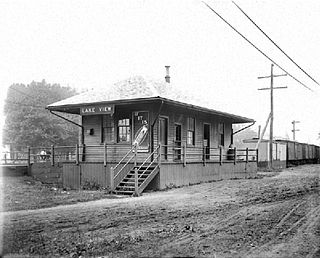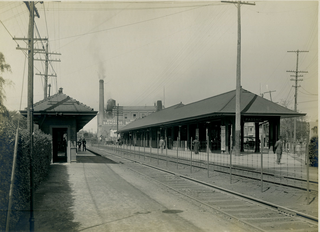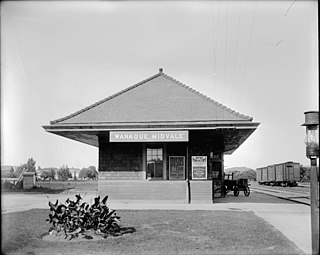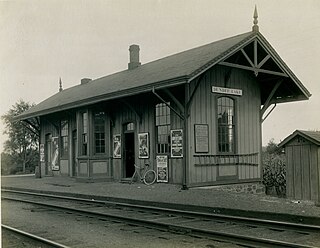
Wood-Ridge is an active commuter railroad train station in the borough of Wood-Ridge, Bergen County, New Jersey. Located next to the interchange of Route 17 and Moonachie, the single low-level side platform station services trains of New Jersey Transit's Pascack Valley Line between Hoboken Terminal and Spring Valley. The next station to the north is Teterboro and to the south is Secaucus Junction. Wood-Ridge station is not accessible to handicapped persons and contains parking along Park Place East.

Montclair Heights is a New Jersey Transit station in the Montclair Heights area of Montclair Township, New Jersey. Located along the Montclair-Boonton Line at the Normal Avenue (CR 618) grade crossing, the station serves trains coming from six different terminals. Depending on the direction of travel, Montclair Heights is either the first or last of six stations in the township. The next station westbound is Montclair State University, which is in Little Falls, while the next station eastbound is Upper Mountain Avenue.

Nanuet station is a train station in Nanuet, New York, serving Metro-North Railroad and NJ Transit trains on the Pascack Valley Line. Its official address is 1 Prospect Street, but in reality, it is located on Orchard Street West, diagonally off the southwest corner of Prospect Street and Middletown Road.

Kingsland is a railroad station on New Jersey Transit's Main Line. It is located under Ridge Road (Route 17) between New York and Valley Brook Avenues in Lyndhurst, New Jersey, and is one of two stations in Lyndhurst. The station is not staffed, and passengers use ticket vending machines (TVMs) located at street level to purchase tickets. The station is not handicapped-accessible. Originally part of the Delaware, Lackawanna and Western Railroad's Boonton Branch, the current Kingsland station was built in 1918.

Hawthorne is a railroad station operated by New Jersey Transit in the borough of Hawthorne, Passaic County, New Jersey, United States. It is the northernmost station in Passaic County along New Jersey Transit's Main Line. Trains coming through Hawthorne service Waldwick, Suffern and Port Jervis to the north and Hoboken Terminal to the south, where connections are available to New York City via Port Authority Trans-Hudson and ferries. The station, accessible only by Washington Place in Hawthorne, contains only two low-level platforms connected by a grade crossing. As a result, the station is not compliant with the Americans with Disabilities Act of 1990.

Carlton Hill station was a railroad station for the Erie Railroad in East Rutherford, New Jersey, United States. Carlton Hill station was the second station along the Erie's main line and the first station after Rutherford Junction, where the Erie's main line forked from the Bergen County Railroad. The station provided service for passengers in Rutherford and East Rutherford's Carlton Hill district and freight billing for the Royce Chemical Company, producer of Royox household cleaner, epoxies and dyes.

Lake View is a former railroad station for the Erie Railroad in the community of Paterson, New Jersey. The station was located at the intersection of Railway Avenue and Crooks Avenue in the Lakeview district of Paterson, just north of the Clifton town line. The station consisted of two platforms, with a small shelter-sized depot on the westbound tracks and no shelter whatsoever on the eastbound side heading towards Pavonia Terminal. The station was first opened in 1883 in the Lakeview district, and remained in use for nearly eight decades. In 1952 and 1953, as a deal made for Passaic, New Jersey, stations at Clifton and Main Street-Passaic were rebuilt. However, Lake View was not, and when the Passaic Plan was enacted on April 2, 1963, the last passenger trains served Lake View served the old 1883 depot. The depot was razed in the autumn of 1967.

Passaic Park station was a former railroad station for the Erie Railroad's main line in Passaic, New Jersey in the epomonyous section of the city. The station was located between the Carlton Hill station and the Prospect Street station. The station was the easternmost of four Erie stations that served the city of Passaic, being demolished in 1963 as part of the abandonment of the railroad line through Passaic and Clifton. Passaic Park station, originally opened as part of the Paterson and Ramapo Railroad, was reconstructed in 1888 as a 57-by-16-foot wooden structure. The wooden station was the common design for station depots used by the Erie Railroad, designated Type IV. The station was replaced in 1923 with a Spanish tile roof station made of concrete and stone, after six years of litigation between the railroad and the city of Passaic.

Passaic station was a railway station for the Erie Railroad in downtown Passaic, New Jersey. The station sat in the center of Main Street at the corner of Madison Street. Though there were three other stations in the city—Prospect Street and Passaic Park to the east, and Harrison Street to the west—the simply named Passaic station was the primary station for the city, located at grade in the busiest section of its main business street.

Clifton was a former train station for the Erie Railroad and Erie-Lackawanna Railroad in Clifton, Passaic County, New Jersey, United States. Located at the intersection of Getty Avenue and Clifton Avenue, the station served as part of the Main Line. The station consisted of tracks on an elevated line above Getty Avenue with the 1952-built station depot on the side. After the closure of Harrison Street station, the station to the southeast was Passaic and the next station to the northwest was the Lake View station in nearby Paterson.

Wanaque–Midvale was a former commuter railroad station of the Erie Railroad's New York and Greenwood Lake Railway branch in Wanaque, New Jersey, United States. When built in 1873, the station served trains running from Pavonia Terminal in Jersey City to Sterling Forest on the New York–New Jersey border alongside Greenwood Lake and trains going to Ringwood on the Ringwood Branch. At the time there were two stations, one at Wanaque and one at Midvale. The next station northbound towards Sterling Forest was Boardville; heading towards Ringwood it was Erskine. The next station south was Haskell.

Essex Fells was the terminus of the Erie Railroad's Caldwell Branch in the Essex County community of Essex Fells, New Jersey. Located at the junction of Oak Lane and Chestnut Lane in Essex Fells, the station was also a connection to the Morristown and Erie Railroad, which continued west through Roseland towards Morristown. The next station north from the Essex Fells station was Caldwell heading northward to Great Notch in Little Falls, where the line connected to the New York and Greenwood Lake Railroad.

Caldwell station was the fourth of six stations on the Erie Railroad Caldwell Branch, located in Caldwell, New Jersey. The station was located on Bloomfield Avenue just north-east of Caldwell College. The station opened in 1891 as the terminus of the Caldwell Railroad, a branch of the New York and Greenwood Lake Railroad that forked off at Great Notch station in Little Falls, Passaic County.

Hackensack was a railroad station in Hackensack, New Jersey on the New York, Susquehanna and Western Railway Main Line, which provided passenger service between the 1870s and 1960s. The station at Main and Mercer Streets opened in 1872; it was replaced with one at River Street in 1950. Public Service trolley lines served both stations.

Bogota was a railroad station in Bogota, New Jersey, at Court Street/Fort Lee Road west of River Road and east of the Court Street Bridge over the Hackensack River. It was located on the New York, Susquehanna and Western Railway Main Line, which provided passenger service between the 1870s and 1960s.

Pompton–Riverdale is a former railroad station in the borough of Riverdale, Morris County, New Jersey, United States. Located at 13 Pompton–Hamburg Turnpike, the station was a stop on the Greenwood Lake Division of the Erie Railroad. A single side platform station with two tracks, the current station was built in 1919. The next station to the north was Pompton Junction, where connections were available to the New York, Susquehanna and Western Railroad, another Erie Railroad subsidiary. The next station south was Pompton Plains.

Pompton Junction is a former railroad station and active railroad junction in the borough of Pompton Lakes, New Jersey, United States. The station is located on the New York and Greenwood Lake Railway and the New York, Susquehanna and Western Railway, both subsidiaries of the Erie Railroad. Pompton Junction contained two side platforms at a diamond crossing, with a station depot on the Susquehanna Railroad side and a station canopy on the Greenwood Lake side. A railroad tower with the telegraph call letters "PJ" was present on the Greenwood Lake side of the station.

Haskell was a former commuter railroad station in the Haskell section of Wanaque, Passaic County, New Jersey, United States. Located at the Doty Road grade crossing in Wanaque, trains operated on the Erie Railroad's New York and Greenwood Lake Railway between Pavonia Terminal in Jersey City and Wanaque–Midvale station. The next station to the north was Wanaque–Midvale while the next station to the south from c. 1909–1930 was Pompton Junction. Afterwards, the next stop was Pompton–Riverdale. Haskell station consisted of a single low-level side platform and a three-sided shelter for protection.

Harrison Street was a former Erie Railroad main line city on the western edge of the city of Passaic, New Jersey. Located at the grade crossing of Harrison Street near Clifton, the station was first/last when entering the city. Heading westbound, the next station was Clifton while the next station east was the downtown Passaic station. The Erie Railroad agreed with the city of Passaic to abandon the station depot at Harrison Street in June 1952 due to low ridership. The station depot, built in 1913, suffered a small fire on July 25, 1952. Demolition of the building began within a week after the fire, though the process took less time due to the flames.

East Paterson was a former commuter railroad train station in the borough of East Paterson, Bergen County, New Jersey. East Paterson station serviced freight and passenger trains of the New York, Susquehanna and Western Railway between the eponymous station in Butler to Pavonia Terminal in Jersey City and Susquehanna Transfer in North Bergen until June 30, 1966. The station contained a single low-level side platform and a 60-by-14-foot wooden frame depot on the north side of the tracks.





















